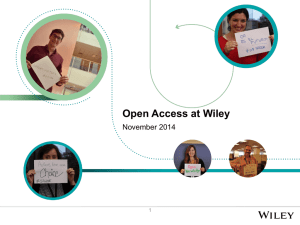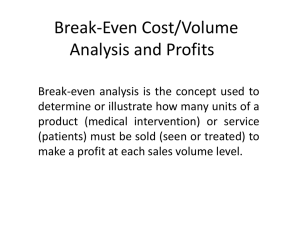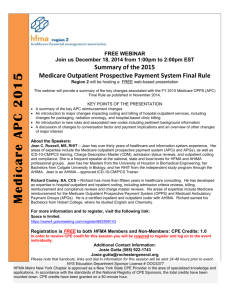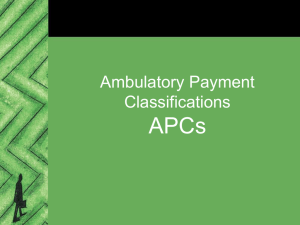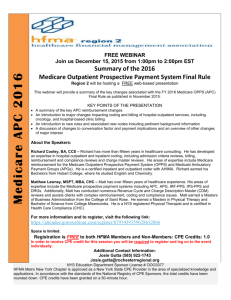Ambulatory Patient Classifications
advertisement
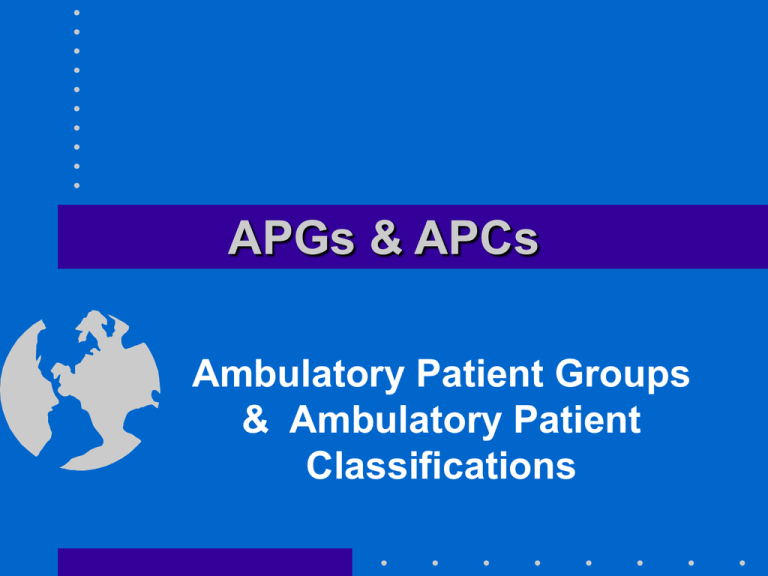
APGs & APCs Ambulatory Patient Groups & Ambulatory Patient Classifications What are APCs • Method used to pay hospitals & ambulatory surgery centers for outpatient services using a prospective payment system (PPS) – Providers receive fixed payments for individual services – Services assigned to various APC categories What are APCs • APCs developed from Ambulatory Patient Groups (APGs) • Amount & type of resources used in an outpatient visit are grouped in APC categories • Services in each APC have similar clinical characteristics, resource use, & cost What are APCs • Each APC group assigned a weight value applied to a conversion factor to yield a hospital payment – Conversion factor for 1999 = $51.42 – Based on 1996 data from claims paid & cost data Why APGs Were Developed • To encompass the full range of ambulatory settings – i.e. same day surgery units, hospital emergency rooms, outpatient clinics • To represent ambulatory patients across the entire patient population • To differentiate facility & control costs – Variation from RBRVS • To focus on primacy of hospital care Current vs. Proposed System • Example: current system – Total charges = $5,963 – Copay (20%) = $1,193 – Total MC allowable = $3,578 – MC payment (80%) = $2,862 • Example: proposed system with outpatient PPS – Total charges = $5,963 – Copay (20%) = $1,193 – Total MC allowable = $3,578 – Actual copay (33%) = ($1193) – Total MC payment = $2,385 Current vs. Proposed System • Variance between systems Difference = Proposed (outpatient PPS) - Current = $2,385 - $2,862 = ($477) – Increased cost control with proposed system of outpatient PPS Cost Reductions With Outpatient PPS • Congressionally mandated – 5.8% reduction in amounts payable for hospital operating costs – 10% reduction in amounts payable for hospital capital costs • Scheduled sunset 9/30/98 • Extended through 12/31/99 Steps in Developing APGs 1 Choosing initial classification variable – DRGs used major diagnostic categories – APCs use procedure categories 2 Partition procedures into set of mutually exclusive procedure groups – Inpatient only vs. outpatient Steps in Developing APGs 3 Procedures done on ambulatory basis then assigned to a class – Significant procedure • Constitutes reason for visit – Ancillary service procedure • Ordered to assist in diagnosis & treatment Steps in Developing APGs 4 Significant Procedure APGs then divided into groups of CPT-4 codes based upon body system associated with the procedure – Integumentary system – Musculoskeletal system – Respiratory system – Cardiovascular system – Hematologic, lymphatic, & endocrine system Steps in Developing APGs 4 APGs divided based upon body system (cont.) – Digestive system – Urinary system – Male & female genital system – Nervous system – Eye & ocular adnexa (accessory parts) – Facial, ear, nose, mouth, & throat Steps in Developing APGs 4 APGs divided based upon body system (cont.) – Therapeutic & other significant radiology procedures – Physical medicine & rehabilitation – Mental illness & substance abuse therapies Steps in Developing APGs 5 Each significant procedure then assigned to a body system & subdivided into clinically similar classes – Example: classes of surgical procedures – Example: classes of medical procedures – Signs, symptoms, & findings + underlying disease provides indication extensiveness of condition Steps in Developing APGs Example: Classes of Surgical Procedures Variable Site Extent Purpose Type Method Device Medical Specialty Example________________ Face, hand, etc. Excision size 2 cm x 20 cm Diagnostic or therapeutic Incision, excision, or repair Surgical, endoscopic, etc. Insertion or removal Urology, gynecology, etc. Steps in Developing APGs Example: Classes of Surgical Procedures • Method = primary classification variable • Extent of procedure also important • Medical specialty, although classified as a variable, not important • Procedures performed by different medical specialties are placed in different APCs Steps in Developing APGs Example: Classes of Medical Procedures Variable Etiology Body system Type of disease Medical specialty Patient age Patient type Complexity Example________________ Trauma, malignancy, etc. Respiratory, digestive, etc. Acute, chronic Internal medicine, pediatrics Pediatric, adult New, old Time required, treatment Steps in Developing APGs Example: Classes of Medical Procedures • Primary variable forming medical APC is diagnosis coded as reason for visit-etiology • Visit complexity also important because it influences number of visits + overhead costs Steps in Developing APGs 6 Development of ancillary service APGs – Laboratory APGs assigned as a function of different lab departments • i.e. hematology, microbiology, toxicology • Testing method also used • Different methods for performing same test assigned to same APC • Also differentiated based on test complexity Steps in Developing APGs 6 Ancillary service APGs (cont.) – Radiology APCs assigned as a function of equipment used • i.e. MRI, CAT, plain film • Nuclear medicine separated into diagnostic & therapeutic groups • Five radiologic procedures are considered significant procedures because they are interventional & meet definition of Significant Procedure Steps in Developing APGs 6 Ancillary service APGs (cont.) – Pathology divided into two APGs as a function of complexity • PAP Smears assigned separate APG – Anesthesia assigned to single APG Steps in Developing APGs 6 Ancillary service APGs (cont.) – Chemotherapy divided into two significant procedures as a function of route of administration • Intravenous • Continuous infusion • Five additional chemotherapy APGs formed as a function of cost of chemotherapy drugs Steps in Developing APGs 6 Ancillary service APGs (cont.) – Other ancillary tests & procedures • EKGs • Pulmonary function tests • Vascular tests Steps in Developing APGs 6 Ancillary service APGs (cont.) – Ancillary APGs performed as part of medical visit & add to cost of visit • Immunizations • Biofeedback • Tube changes • Minor reproductive procedures • Needle or catheter introduction • Minor ophthalmological procedures Components of APC-Based Outpatient PPS • Basis of payment weights – Charges or costs – Higher if computed from historical charges – Therefore, historical cost basis more likely Components of APC-Based Outpatient PPS • Ancillary packaging – Inclusion of certain ancillary services into APC rate for significant procedure or medical visit – Full packaging of all routine low cost procedures is likely Components of APC-Based Outpatient PPS • Outlier policy – Covers atypical cases having higher costs than APC payment amount – A stop loss provision – Likely to be minimized Components of APC-Based Outpatient PPS • Discounting – When multiple significant procedures are performed or when same ancillary procedure performed multiple times • Window of time for ancillary packaging – Can be expanded well beyond the day of a visit APC Payment System • Patient is described by list of APCs corresponding to each service provided to that patient • Contrast to DRGs – Multiple APCs can be assigned to a single patient whereas DRGs form a hierarchy • Example: Patient has two procedures performed + chest x-ray + blood test – Four APCs are assigned APC Payment System • Incentives to encourage efficiency & to stanch upcoding are built into system – Ancillary packaging • Services that contribute to the cost of services in an APC but which are not paid for separately • i.e. chest x-ray packaged with patient pneumonia visit APC Payment System • Incentives (cont.) – Ancillary discounting • Multiple procedures – 100% of APC with highest payment rate & 50% for all other APCs – i.e. multiple significant procedures performed or same procedure performed multiple times • Two surgical procedures performed at same time but the cost of prep & use of procedure room is shared by procedures • Therefore a discount is applied • Terminated procedures APC Payment System • Use of beneficiary copayment – National unadjusted copayment using 1996 median charges + 135 for 1999 • Multiplied by 20% – Minimum copayment • Payment rate x 20% APC Payment System • Medicare payments – Wage adjusted APC payment – Pay the lesser of the program percentage determined for each APC or 80% Example: APC Payment • Breast biopsy: • Relative weight (RW): • Conversion factor (CF): APC 197 11.94 $51.42 Proposed Payment Rate = RW x CF = 11.94 x $51.42 = $613.95 Total Payment = $613.94 + patient copay Number of APCs APC Type____________________# of APCs Significant procedure 47 Procedure 133 Ancillary services 44 Visits to clinic & ER 120 Partial hospitalization services__ 1___ TOTAL 345 Update:10/3/99 Outpatient Services Grouped into APCs • Partial hospitalization services furnished in community mental health centers & hospitals • Surgical procedures – Designated only • Radiological procedures – Includes radiation therapy • Diagnostic services & tests Outpatient Services Grouped into APCs • Screening tests that are covered – i.e. colorectal screening • Medical services & covered vaccines when furnished by a provider of services – Medical services include antigens, splints, casts, etc. – Vaccines include pneumococcal, influenza, hepatitis B, etc. Outpatient Services Grouped into APCs • • • • • Clinic visits Emergency Department visits Chemotherapy for cancer Surgical pathology Supplies – i.e. surgical dressings Outpatient Services Grouped into APCs • Services furnished to SNF inpatients exempt from consolidated billing – i.e. MRI, CT scans, cardiac catheterization, ambulatory surgery, ER visits, angiography, lymphatic & venous procedures, radiation therapy, etc. • Services furnished to inpatients who have exhausted Part A benefits or otherwise not covered under Part A Advantages of APCs Advantages of a Visit-Based APC PPS • Many similar services are aggregated thereby reducing the number of service units • Need to establish separate payment rates for minor differences in the unit of service is eliminated – i.e. 99211 vs. 99212 Advantages of a Visit-Based APC PPS • Opportunity for unbundling units of service is greatly reduced • Financial incentives as used package ancillary services efficiently • Multiple procedures during a single visit reasonably compensated but not excessively rewarded Advantages of a Visit-Based APC PPS • Payment of medical visits a function of type of patient treated, not level of effort reported by physician • Ultimately, greater control of costs • Expected that other third party payers will follow HCFA’s lead in using APCs for outpatient reimbursement – i.e. DRGs, RBRVS Implementation of APCs Implementation Issues to be Addressed • Volume of visits – Must work to minimize incentives to increase visits for certain services • Upcoding & fragmentation of procedure codes – New compliance issues for providers Implementation Issues to be Addressed • Identification of visits – Clear rules needed on reporting dates of service, what revenue trailers are to be permitted or prohibited, & how how batched bills are to be submitted • Shift of ancillaries to non-hospital settings due to ancillary packaging – Must be able to identify hospital-ordered procedures performed in non-hospital setting Implementation Issues to be Addressed • Payment of ancillaries ordered outside of hospital – Must be mindful of incentives to shop for most advantageous price to the provider • Applicability – Will PPS be applicable to non-hospital entity providing similar services Implementation Issues to be Addressed • Consistency with inpatient payment levels – Must be mindful for financial incentives to move patient services Implementation Issues to be Addressed • Computation of prospective APC payment rates – Must watch to see if a practice’s historical cost structure has been too high – This will peg APC too high Implementation Issues to be Addressed • Hospital specific payment adjustments – Need to be careful regarding inclusion of adjustments for labor costs & outliers • Can render APCs at too high a level – Can occur when single procedure reported using multiple procedure codes Implementation of APCs • APC implementation projected to occur between July 1, 2000 and January 1, 2001 Preparing for APCs Activities to Prepare for APCs • Budgeting & planning – Estimate expected revenues • Focus activities – Categorizing services appropriately – Training for physicians – Accurate coding • Develop baseline to evaluate progress – Goals to decrease errors & increase reimbursement Provider Responsibilities • Accurate & complete coding for services • Adequate documentation in medical records to support APC category assignments Importance of Data Quality • Quality of data recorded on claims will directly affect reimbursement – Providers will either undercode or overcode • Quality of provider’s historical claims data will affect ability to evaluate potential impact of APCs Balanced Budget Act Balanced Budget Act of 1997 BBA of 1997 • Enacted August 5, 1997 • Required HCFA to adopt an outpatient PPS by January 1, 1999 – Delayed due to Y2K issues Balanced Budget Act Revisions Balance Budget Refinement Act 1999 Key Changes to BBA • Reverse 5.7% payment reduction in the conversion factor – System is supposed to be budget neutral – Conversion factor should be calculated so that fee schedule amounts under PPS would equal the total amounts estimated by DHHS to be paid for outpatient services Key Changes to BBA • Transition to outpatient PPS – 3 year transition to protect against significant payment reductions – Affects hospitals & ambulatory surgery centers Key Changes to BBA • Delay PPS implementation for rural hospitals – 3 year cost-based reimbursement option – Must have less than 100 beds Key Changes to BBA • Outlier adjustment for high cost cases & transitional pass-through payments for new drugs & medical devices – 2-3 year transitional pass-through for additional costs of innovative devices & drugs – Payments must be budget neutral & cannot exceed portion of all outpatient payments – Due to underpayment & potential prevention of the introduction of new drugs & devices Key Changes to BBA • Limitation on outpatient hospital copay for a procedure to the inpatient hospital deductible amount – Copay cannot exceed inpatient deductible – Medicare will increase payment to hospital to reflect copay reduction Key Changes to BBA • Therapy caps moratorium – Will not apply until implementation of consolidated billing – Recommend to include appropriate utilization & functional status in payment modifications Key Changes to BBA • Secretary required to review outpatient payment group rates annually & update when necessary • Payment for implantable devices made through outpatient PPS Administrative Changes • More homogenous APC groups – Will also create new APCs where needed to provide accurate payments for services provided – Will prevent payment redistributions Administrative Changes • Unbundling of supportive therapies – Separate APCs for supportive & adjunctive therapies for cancer patients – Originally had reimbursement bundled with other APC groups Administrative Changes • Unbundling of blood products – Separate APCs for blood, blood products, & anti-hemophilic factors – Originally had reimbursement bundled with surgical procedures & transfusions Administrative Changes • Cost-based payment for corneal tissue – Cover actual costs to prevent both underpayment & overpayment – Originally bundled with corneal transplant surgery Administrative Changes • Elimination of diagnosis code for medical visits – Not required for payment calculations – Payment was to be based on procedure (CPT) & diagnosis (ICD-9) codes Administrative Changes • Volume control mechanism delayed – Gives providers time to adjust to new system – Would eventually reduce reimbursement should hospitals exceed target patient volumes
